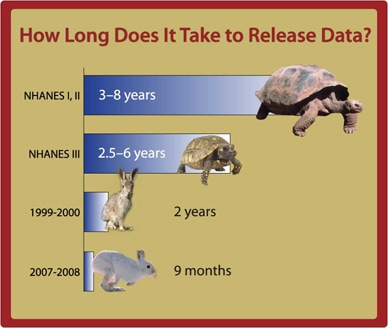
NHANES Consortium to Meet April 7, 2010
After a long interval, the next NHANES Consortium will meet once again on Wednesday, April 7th, 2010. All past, present, and future NHANES Federal collaborators are invited to participate in the upcoming meeting. (A separate meeting will be scheduled soon for our other stakeholders.) This meeting offers an opportunity for stakeholders to get updates, share information, and discuss issues and future plans for the survey. The Consortium met regularly from the mid-1980s through 2001. We plan to resume the Consortium meetings on a periodic basis to better communicate simultaneously to past, present and future collaborators, as well as to provide an opportunity to discuss issues with NHANES staff and with one another.
Please save the date if you are interested, and note that the Consortium meeting will be held from 1:30-3:30 pm in Hyattsville, Maryland, at NCHS (easily accessible by metro's Green Line or by car with ample parking available). Videoconferencing is available. Please reply to NHANESNews@CDC.GOV to inquire about Envision set up. We will provide updates when more details of the program become available.
Stored Specimens Available for Lab Studies
Do you want to conduct laboratory assessments on a health topic using NHANES data? Here is the good news: you neither need to spend a dime collecting the data, nor have to wait for the data to be collected - they are right here waiting for you!
The NHANES Stored Specimen Program offers investigator-driven research opportunities, with laboratory testing conducted in the investigator’s own facility. To add to the large amount of information collected for the purpose of describing the health of the population, serum, urine and limited plasma samples were collected and stored for future research projects. Specimens are currently available from NHANES III (conducted from 1988–1994) and from NHANES 1999–2008. In 1999, NHANES became a continuous survey with data release every two years. Specimens are available from two year survey cycles after the demographic file has been released to the public. Participants in the survey that began in 1999 signed a separate consent document agreeing to specimen storage allowing their biologic specimens to be used for approved research projects.
To date there have been 37 projects completed using specimens collected in NHANES III and 15 projects completed using specimens from the current continuous NHANES. Projects span a variety of topics, from the prevalence of mumps to an estimation of blood mercury concentration and frequency of shellfish meals in the U.S. population. Your project could be next.
If your proposal is accepted, the specimens will be provided at a nominal cost per vial. To find out more about the program and the guidelines for submitting proposals, please read the Stored Biological Specimen Proposal Guidelines.
MECs Get New Lab Trailers
Each mobile exam center (MEC) is made up of four trailers which are interconnected at the survey location. There are three MECs. In rotating fashion, two MECs are in operation while the third one is moving and getting set up at the next location. As part of an effort to update the aging NHANES infrastructure, DHANES worked with GSA and their contractor to design and build new laboratory trailers. The laboratory trailers have been in use for over 20 years beginning in NHANES III.
Following the successful integration of one new laboratory trailer in August, 2009, two more new lab trailers were ordered and received in December. As the MEC moves from one location to another, the old lab trailer is being swapped out, and the new trailer integrated. These new trailers will be fully integrated by March, 2010, ensuring that the NHANES laboratory continues to function seamlessly.
Remembering the Past and Embracing the Future
NHANES Communities Celebrate the 50th Anniversary
 2009 marks the 50th anniversary of the first National Health Examination Survey, which was fielded in October, 1959. The NHANES communities have organized a series of programs to celebrate NHANES’ many landmark achievements in monitoring the nation’s health.
2009 marks the 50th anniversary of the first National Health Examination Survey, which was fielded in October, 1959. The NHANES communities have organized a series of programs to celebrate NHANES’ many landmark achievements in monitoring the nation’s health.
On September 29th, 2009, DHANES hosted a program attended by approximately 200 guests. The program featured a recorded statement from CDC director, Dr. Thomas Frieden, and remarks by Dr. Steve Thacker, Acting Director of CDC’s Office of Surveillance, Epidemiology, and Laboratory Services (OSELS). Following a journey through 50 years of NHANES history with the current NHANES Director, Cliff Johnson, a panel of current and former field staff including Jack Powers and Pat Montalvan from Westat, and current DHANES employees, Ana Chaves, Ivy Braddock and Brenda Lewis, shared stories of what it was like living on the road, and the constant unexpected challenges faced by the field staff. The collaborators’ panel was represented by Dr. Paul Coates from NIH, Dr. Kathy Ellwood from FDA, Dr. Eric Sampson from CDC, and Dr. Joe Spence from USDA. They related their good times and challenging moments in efforts of integrating data needs through inter-agency collaborations. Lastly, the current Director Cliff Johnson and former Directors Bob Murphy and Dr. Raynard Kington shared their experiences and congratulated the DHANES staff, collaborators, and most of all survey participants for making the survey possible all these years.
On November 4th, 2009, Congresswoman Rosa DeLauro of Connecticut hosted a program on Capitol Hill. In addition to the Congresswoman, speakers included NCHS Director, Dr. Ed Sondik; CDC Director, Dr. Thomas Frieden; OMB Chief Statistician, Kathy Wallman; and NHANES Director, Cliff Johnson. The event was very well attended with guests representing multiple congressional offices, the Congressional Research Service, the American Society for Nutrition, the American Heart Association, General Mills, the March of Dimes, the International Life Sciences Institute, PhRMA, COPAFS, ASA, the Census Bureau, several NIH Institutes, USDA, and more. Many thanks to those members of the Friends of NCHS who sponsored the reception!
The annual field staff training in January, 2010 offered an opportunity for the field staff to join in the celebration. In addition to their regular training, field staff got some extra items on their agenda: viewing the documentary video featuring stories from the past and current NHANES employees, revisiting an electronic version of the 50th exhibition created by DHANES staff, and most of all, enjoying a birthday cake exquisitely designed with the 50th logo!
More Asian Pacific Islanders to be Included in 2011-2014 Survey Cycle
The NHANES sample is redesigned every four years, and the design for 2011-2014 is now being finalized. Beginning in 2011, the sample size for Asian Pacific Islanders (APIs) will be increased to about 750 per year. This is a substantial increase from the 2007-2010 design, which sampled approximately 100 APIs per year. Because of the small sample size, no descriptor for APIs appeared on the public use data file previously. When the 2011-2012 data cycle is released, the expected number of APIs in the sample should be close to 1,500 and the race/ethnic data will include a category for APIs.
In terms of the overall sample change between the 2007 and the 2011 design, the percentage of Non-Hispanic Black Americans will stay the same (24 percent); Hispanics will change from approximately 31 percent to 24 percent, and Asian Pacific Islanders will come in 2011 with 15 percent. For the Non-Hispanic Whites, NHANES will continue to oversample those with low-income with 13 percent in the 2011 sample. The proportion in the remaining income categories for Non-Hispanic Whites will decrease from 31 percent to 24 percent. In terms of analysis of the data, while some measures for APIs can be conducted on the two-year dataset, the full four years of data (2011-2014) will be necessary for many analyses.
Then & Now
The Change of Pace in Data Release

NHANES has reduced the amount of time to release data to mere months. From NHANES I, when the data took several years to release, to the release of the 2007-2008 survey data, which was released nine months after data collection ended.
So far, sixty-nine 2007-2008 public datasets have been released, plus the documentation for seven datasets available through the RDC.
If you do not wish to receive future newsletters, please email NHANESNews@cdc.gov to be removed from our mailing list.